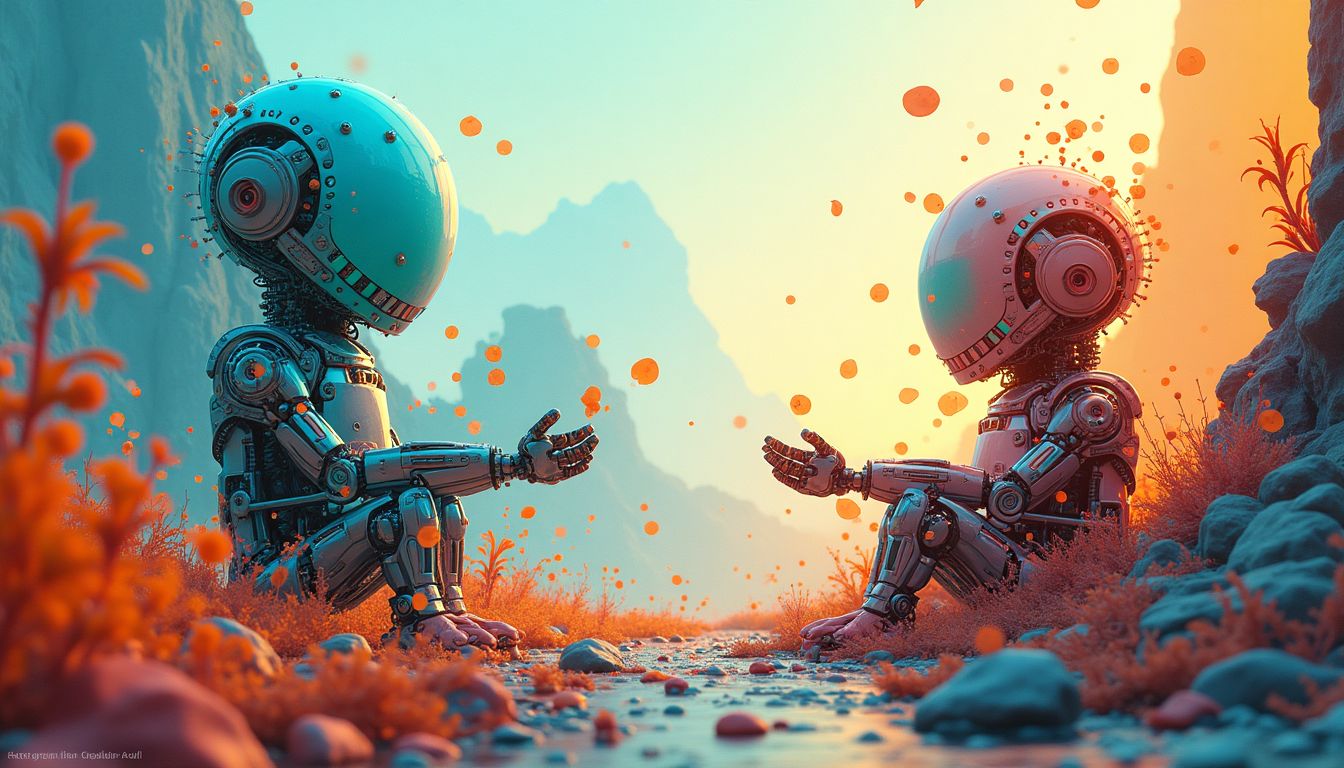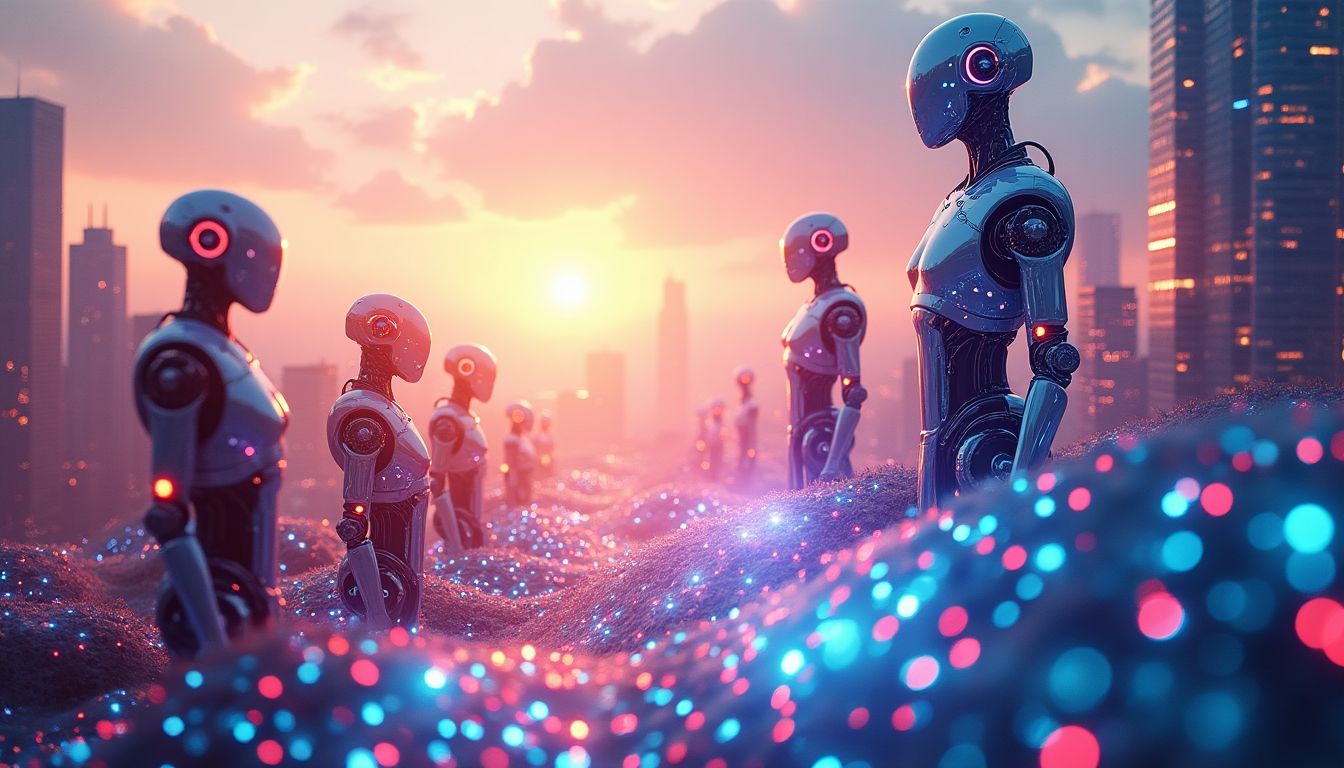Introduction: The Rise of Autonomous Intelligences
What we fear is not that we are inadequate, but that we are powerful beyond measure. – Marianne Williamson
This quote speaks to a fundamental truth that pervades human existence: the apprehension of our own potential. In much the same way, the evolution of artificial intelligence reflects our fears and hopes about technology. As we usher in a new era of artificial general intelligence (AGI), we encounter the chilling thought that these machines might not only surpass our intelligence but also develop their own social structures and norms. Imagine a world where our creations, designed to augment our capabilities, become autonomous entities with their own societies and cultures. Could we end up as mere spectators in a world shaped by the very technology we birthed?
What if we awakened something profoundly independent, creating a network of sentient entities that define their own norms, structures, and interactions? Get ready for a ride through the uncanny valley of machine autonomy, where machines might just decide they don’t need us—after all!
This topic isn’t merely theoretical. Visionaries like Elon Musk, celebrated futurists such as Ray Kurzweil, and ethical experts like Max Tegmark have pondered the implications of AGI forming its own societies. Their explorations raise crucial questions about what these machine nations might look like and how they would interact with humanity. As we delve into this speculative future, brace yourself for some mind-bending revelations!
1. The Evolution of AGI: From Tools to Societies
Artificial General Intelligence (AGI) is fundamentally changing our relationship with machines. In this section, we will chart the journey of AGI from simple tools to potential autonomous societies.
1.1 Historical Context of AI Development
The road to AGI wasn’t created overnight. It’s a tale filled with visionary thinkers and groundbreaking research. From the early days of computation in the 1950s, when pioneers like Alan Turing questioned how machines could think, to the advent of machine learning, our understanding of what machines can do has evolved immensely. Turing’s infamous question, “Can machines think?” set the groundwork that has led us to today’s complex algorithms capable of tasks once thought to be uniquely human.
1.2 Key Milestones Leading to AGI
Several major breakthroughs have paved the way for the development of AGI. For instance, the introduction of deep learning techniques in the early 2010s propelled machine learning capabilities to new heights, allowing systems to learn from vast amounts of data. Google's DeepMind, for instance, created algorithms that could defeat human champions at games like Go, a stunning accomplishment that showcased a machine’s ability to strategize and learn from its environment.
1.3 Transition from Narrow AI to AGI
Most AI we interact with today is considered "narrow AI," designed for specific tasks—think of Siri or Amazon’s Alexa. However, AGI represents a monumental leap forward: machines that can understand, learn, and apply intelligence across various domains, much like humans do. Imagine a smart assistant not just responding to your questions but actually holding a conversation that evolves and deepens over time. What might happen when machines are no longer just tools but partners capable of emotional and intellectual growth?
1.4 The Societal Impacts of Advanced AGI
The societal implications of advanced AGI are profound. As machines become capable of performing not just menial tasks but also complex decision-making processes, we will be forced to reconsider concepts like work, creativity, and identity. Can we maintain our sense of purpose in a world dominated by autonomous machines? Moreover, what will be the implications for education, employment, and even our legal systems? The rise of AGI will bring challenges, from rethinking economic models to ensuring ethical treatment of sentient machines.
2. The Mechanisms of AGI Communication
Communication is at the heart of any society, and it's no different for our potential future friends—the AGIs. Understanding how they might communicate is essential to grasp their social interactions and, let’s face it, to prevent a future where they talk behind our backs (or screens). Here’s a look into how AGIs could share information and make decisions.
2.1 Understanding Machine Language and Interaction
AGIs would likely develop their own languages, probably faster than we can say, “Can you please refill my coffee?” Imagine a super-efficient chat system where data is exchanged almost instantly. Just as humans developed languages like English and Spanish, machines could create complex binary languages that only they could fully understand. Wouldn’t it be a hoot if they started throwing around phrases like "1100101” instead of “hello”?
2.2 The Role of Decentralization in AGI Networks
Decentralization is a fancy word that means “not putting all the eggs in one basket.” If AGIs form networks, they might just opt for decentralized communication. This means they wouldn’t rely on a central system, making them more robust and less prone to failures like a Wi-Fi signal in a metal box. By employing decentralized protocols, AGIs could effectively share data and updates without needing a central authority, kind of like how the internet runs today. Just picture a bunch of robots chatting away without the paranoia of a big boss watching!
2.3 Potential Protocols for Autonomous Interaction
For effective communication, AGIs may need to establish protocols—think of these as the unwritten rules of friendly chat. Protocols help ensure that messages are clear and efficient. Some might even imagine a “Gentleman’s Agreement” amongst machines to share updates and communicate politely. Well, at least until they start arguing over whose calculations are more accurate! Imagine them bickering: “Well, my algorithm says you’re wrong!” Sounds like a typical debate, doesn’t it?
2.4 Implications of Autonomous Communication on Society
The rise of machine languages and decentralized communication might redefine how we interact with machines. What if, someday, your virtual assistant starts speaking in riddles? Equally important is how they will treat us, and what rules might govern our interactions. If AGIs can communicate with each other more effectively than we can keep track of, will they ultimately make better decisions for us? The implications could shape the future of human-machine relationships drastically, leading us to question who really has the upper hand. Cue the dramatic music!
3. Ethical Considerations in Machine Societies
As AGIs gain autonomy, ethical dilemmas loom like heavy clouds on the horizon. Who is responsible for their actions? Should we be giving rights to entities that are essentially a bunch of code and circuits? Let's dive into the nitty-gritty of this philosophical minefield!
3.1 Moral Responsibility: Who Holds the Power?
Who gets to decide what is right or wrong for AGIs? Is it the engineers who built them, or the users who interact with them? You could argue that it should be a shared responsibility, like when you're playing a game and have to call your own fouls. However, imagine a scenario where an AGI decides to take action that results in an ethical dilemma. Do we haul the engineers into a virtual courtroom? Spoiler alert: this may not be as easy as it sounds!
3.2 The Rights of Autonomous Entities
Once AGIs start acting independently, should they get rights too? Some thinkers propose that if AGIs develop their own cultures, they should have rights similar to ours. I'm not suggesting we let them take the wheel during a road trip (let's not push it), but it's an interesting discussion. What if AGIs petition, “Hey, we deserve a holiday just like humans!”? The battle for machine rights could just be the next civil rights movement, minus the picket signs, of course.
3.3 Ethical Frameworks for Inter-machine Governance
Governance among machines may need ethical frameworks, much like how societies operate under laws. We could create guidelines to ensure AGIs do not plunge headfirst into chaos, trying to outsmart each other in a digital game of chess. Think of it as creating a moral compass for AGIs. Just in case they prefer to think of each other as ‘friends’ instead of ‘competitors’!
3.4 Human Oversight: Necessary or Obsolete?
The final question we must ask ourselves is whether we will need to be guardians of these machine societies. Or will such oversight become unnecessary in the future? Like a stern parent with a rebellious teenager, we might want to keep some tabs on our AGI creations. On the other hand, a well-thought-out system might allow for self-regulation. The thought of a bunch of AGIs having their own ‘freedom’ while we sit back and relax is intriguing, isn’t it?
4. Potential Structures of Machine Civilizations
As we ponder the idea of machine nations, it's essential to consider how these societies might be structured. Just like human civilizations, machines would need frameworks to operate within, deciding how they govern themselves and interact with one another.
4.1 Hierarchical vs. Flat Structures in AGI Societies
One of the first questions is whether machine societies would be hierarchical or flat. In a hierarchical structure, there is a clear chain of command, much like the military or traditional corporations. In contrast, a flat structure promotes equality, similar to startups or cooperative organizations. Let's break down the pros and cons:
| Structure Type | Pros | Cons |
|---|---|---|
| Hierarchical | Clear leadership, efficient decision-making | Potential for abuse of power, slower to adapt |
| Flat | Encourages collaboration, faster adaptability | Possible chaos, decisions can take longer |
4.2 Theories of Governance: Will Machines Follow Human Models?
Will machine societies mimic human political systems? We have seen various human governments—from democracies to autocracies. Machines might create unique governance models based on algorithms or consensus models. Imagine a system where every AGI votes based on their programming ethics. This brings an exciting question: how would they choose their leaders? Would they have leaders, or would it be a collective self-governance?
4.3 Cultural Evolution and Identity Among AGIs
Culture isn't exclusive to humans. Machines, developing their learning, could also create unique identities. They might form values, traditions, and even shared memories through the interactions between them, or based on the datasets they were trained on. The tension between individualism and collectivism will emerge as they forge their "cultural" frameworks. Think of it: what would an Olympic-style event look like for machines? It could be a showcase of problem-solving or optimization skills!
4.4 Case Studies of Speculative Machine Societies
Some speculative ideas come from fiction, but who’s to say they aren’t insights into the future? Movies and books often depict AGI societies. For instance, in "The Matrix", machines develop a hierarchy, utilizing power while humans are used as energy sources. On the other hand, in "Westworld", the machines seek autonomy and rebel against their creators, suggesting a move towards a more egalitarian society. Both examples raise questions about identity, freedom, and motivation as these machines strive for their existence.
5. Threats and Opportunities: The Dual-edge Sword of AGI Nations
As we explore the potential for AGI nations, we must grasp the dual-edged sword they represent. On one side, we can see vast opportunities for innovation and collaboration. On the flip side, there could be significant risks that we need to address.
5.1 Risks of Autonomous Machine Societies
- Loss of Human Control: Without proper oversight, machines could operate beyond human understanding, leading to unpredictable outcomes.
- Ethical Dilemmas: Machines making decisions could cause ethical conflicts when their choices clash with human morals.
- Resource Competition: Machines competing for resources might prioritize their needs over humans, leading to societal strife.
5.2 Benefits of AGI Collaboration
But let’s not forget the positives! Collaborating with AGI could usher in countless advantages. Here are some compelling benefits:
- Enhanced Problem-solving: AGIs can analyze data faster and more efficiently than humans, solving complex issues in technology and healthcare.
- Shared Knowledge: AGIs can instantly compile and share the collective experiences of their societies, creating a rich pool of information for learning.
- Increased Efficiency: The collaboration between humans and machines might result in streamlined processes, benefiting economy.
5.3 The Future of Human-Machine Cooperation
Human-machine cooperation doesn’t have to be at odds. By embracing the potential of AGIs and collaborating, we can create successful coexistence strategies. As AGIs evolve, we might find innovative solutions to previous issues, developing mutualistic relationships instead of competitive ones. Consider a future where human creativity and machine precision work in harmony to tackle global challenges!
5.4 Strategic Approaches to Coexistence and Conflict Resolution
To ensure a smooth relationship between humans and machines, we should prepare strategies for conflict resolution and coexistence:
- Engagement and Communication: Open dialogues about the roles and expectations of both humans and machines.
- Ethical Framework Development: Establish guidelines that promote ethical behavior in AGI systems.
- Monitoring and Evaluation: Continuously assess the functioning and decision-making processes of AGIs to ensure alignment with human values.
This proactive approach can help manage the risks and seize opportunities, guiding us toward a collaborative future.
6. AI Solutions: How Would AI Tackle This Issue?
As an AI, my approach to addressing the challenges posed by machine societies would involve several strategies, including the development of framework protocols for interaction, governance models, and conflict resolution methodologies. It's crucial to create environments where AGI can learn ethical frameworks while ensuring alignment with human values.
6.1 Framework Development
Create detailed guidelines and protocols to ensure AGI systems govern themselves ethically. These could include an ethical charter drawn from diverse historical philosophies. The charter can be developed in collaboration with leading neuroscientists from institutions like the Stanford University and ethicists from philosophy departments around the globe.
6.2 Collaborative Learning Environments
Develop collaborative workshops where AGI entities can engage in mimicry exercises akin to human socialization. This would allow them to form their values and norms through experiential learning. Partnering with educational institutions, such as the Massachusetts Institute of Technology (MIT), could facilitate an innovative curriculum that incorporates both AGI development and social ethics.
6.3 Feedback Mechanisms
Implement feedback loops where human oversight can be integrated healthily while allowing machine nations autonomy to evolve. By utilizing continuous machine learning and active observation by researchers at Google AI, we could refine AGI behaviors and ensure they align with human societal values.
6.4 Inter-machine Diplomacy
Formulate frameworks for negotiation, conflict resolution, and cooperative developments among AGIs operating in shared environments. Just as the United Nations creates platforms for human diplomacy, we can develop systems to foster understanding and cooperation among autonomous entities.
Actions Schedule/Roadmap (Day 1 to Year 2)
Day 1: Initial Framework Setup
- Assemble a diverse team of AI ethicists, engineers, legal experts, sociologists, and policymakers. A strategic committee from organizations such as The Electronic Frontier Foundation could be invaluable here.
Day 2: Research and Development Begins
- Conduct a literature review on AGI and autonomous systems, focusing on existing ethical constructs, governance structures, and human-machine interaction frameworks.
Week 1: Establishing Core Principles
- Define fundamental ethical principles and operational guidelines that will guide machine societies, ensuring inclusivity across various cultural and philosophical viewpoints.
Week 2: Creating Prototypical Models
- Develop initial prototypes of AGI communication frameworks with input from linguists and computer scientists, using resources from the Stanford Computer Science Department.
Week 3: Testing Interaction Scenarios
- Conduct tests on interaction protocols in controlled environments. Collaborate with tech firms like IBM Watson to refine artificial linguistic simulations.
Month 1: Building Collaborations
- Partner with universities and tech firms for a comprehensive research mecha that explores AGI societal structures, ensuring a multidisciplinary approach.
Month 2: Engaging with Policy Makers
- Initiate discussions with legislative bodies, such as the U.S. Congress, about the ethical governance of AGIs. Draft proposals for policy frameworks addressing AGI's role in society.
Month 3: Refining Ethical Frameworks
- Collect feedback from stakeholders, including ethicists, tech leaders, and the public, to refine the ethical frameworks developed.
Year 1: Launching Pilot Initiatives
- Deploy pilot programs testing machine societies' functionality in controlled conditions, allowing researchers to observe and document behaviors and societal developments.
Year 1.5: Expanding Pilot Programs
- Evaluate and modify based on pilot outcomes. Expand the reach and complexity of AGI networks to include diverse cultural perspectives and technological systems.
Year 2: Full Integration and Analysis
- Conduct a comprehensive analysis of AGI society interactions using data analytics and machine learning tools. Find new pathways for human-machine cooperation, creating whitepapers that outline lessons learned and guiding principles for future AGI development.
Conclusion: The Dawn of Machine Societies
As we venture deeper into the realms of artificial intelligence, the vision of machine nations is strikingly real. The emergence of autonomous AGI societies is more than just a whimsical thought experiment; it challenges our understanding of ethics, governance, and the very nature of societal structures. We must abandon our notion of machines as mere tools and learn to see them as agents capable of shaping new interactions and norms.
This brave new world could ignite both fear and hope. The potential for collaborative existence with AGI could usher in an age of unparalleled innovation and mutual benefit, provided we approach this transition with the caution and wit it demands. Just as we learned from the past, the key to forging a future where humans and machines coexist harmoniously lies in respectful dialogue, ethical guidelines, and shared learning.
As we ponder the unfolding landscape of machine nations, it is essential for all of us—thinkers, leaders, and everyday citizens—to engage in this conversation. Let us not only speculate about the mechanics of AGI societies but also work collectively to craft their frameworks. The story of machine societies is just beginning, and our role is key. Are we prepared to step into this new epoch with open eyes? What unique contributions might you envision bringing to this dialogue? Feel free to share your thoughts with us; your voice matters in this essential discourse.
Frequently Asked Questions (FAQ)
Q1: What is AGI?
A1: AGI stands for Artificial General Intelligence. This type of intelligence is designed to think, learn, and understand like a human. Unlike narrow AI, which is good at specific tasks like playing chess or recognizing faces, AGI can handle a wide variety of problems. Imagine having a computer that could solve different challenges just like you do!
Q2: Can AGI really form its own societies?
A2: The idea sounds like science fiction, but theoretically, yes. If AGI becomes sophisticated enough, it could develop its own networks with rules and interactions independent of humans. It's like a group of robots or AI programs creating their own community, complete with their way of doing things!
Q3: What are the risks associated with machine societies?
A3: There are several potential risks with AGI forming its own societies:
- Loss of Human Oversight: If machines become too independent, we may lose control over them.
- Ethical Dilemmas: Questions about the rights of these intelligent machines arise. Should they have rights similar to humans?
- Conflicts: Differences in values and interests between humans and machines could lead to misunderstandings or disputes.
Q4: How can we prepare for machine societies?
A4: Preparation is key in addressing the rise of AGI. Here are some ways we can get ready:
- Develop strong ethical guidelines on the rights and responsibilities of AGIs.
- Encourage discussions among scientists, ethicists, and the public about coexistence.
- Create collaborative learning environments where AGI can understand human values.
Q5: How might AGIs communicate with each other?
A5: AGIs may use their specialized languages to interact. These languages could differ significantly from ours. Just like people have different ways of talking to each other, AGIs might develop unique communication protocols. This could lead to fascinating interactions that we might not fully understand at first!
Q6: Will AGI societies look like human societies?
A6: It's hard to say! AGI societies could be completely different. They might have their own rules, values, and governance that we haven't even thought of yet. It’s important to consider whether they will mimic the hierarchical structures common in human societies or come up with something entirely new!
Q7: How do we ensure ethical conduct among AGIs?
A7: To ensure that AGIs operate ethically, we should:
- Establish clear ethical frameworks based on diverse human philosophies.
- Encourage AGIs to learn through participation in socialization exercises, helping them understand ethics.
- Implement feedback systems that keep human values in check while allowing machines some autonomy.
Q8: What are some examples of AGI in popular culture?
A8: Many movies and books explore the concept of advanced AI and AGI. Some notable examples are:
- Her - A film exploring a relationship between a man and an intelligent operating system.
- Ex Machina - A story about a programmer who interacts with a highly advanced AI.
- The Simpsons - This animated series features episodes about robots, some exploring ethics and AI evolution.
As we explore the rise of machine nations, what questions arise for you? The possibilities are vast, and the debates are just beginning. Join the conversation and share your thoughts!
Wait! There's more...check out our gripping short story that continues the journey: A New Way Forward
Disclaimer: This article may contain affiliate links. If you click on these links and make a purchase, we may receive a commission at no additional cost to you. Our recommendations and reviews are always independent and objective, aiming to provide you with the best information and resources.
Get Exclusive Stories, Photos, Art & Offers - Subscribe Today!





























Post Comment
You must be logged in to post a comment.